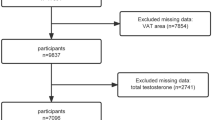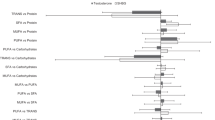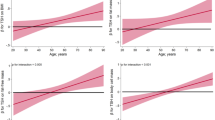Abstract
The objective of the present study was to examine the association between body fat distribution and total testosterone (TT) and free testosterone (FT) levels among middle-aged and elderly men. A total of 922 male residents aged 40–70 years from a community in Shanghai, China, participated in the study. Their waist circumference (WC), waist-height ratio (WHtR), body mass index (BMI), and TT and FT concentrations were measured. Logistic regression models were used to estimate testosterone deficiency risk on the basis of anthropometric indices. BMI, WC and WHtR were all associated with TT deficiency. The participants in the highest quartiles of above-mentioned anthropometric indices had the highest risk of TT deficiency (BMI: odds ratio (OR)=4.40, 95% confidence interval (CI)=2.69–7.19; WC: OR=3.47, 95% CI=2.14–5.60; WHtR: OR=2.89, 95% CI=1.76–4.76). WC and WHtR were associated with FT deficiency. The participants in the highest quartiles had the highest risk of FT deficiency (WC: OR=1.87, 95% CI=1.18–2.97; WHtR: OR=1.67, 95% CI=1.04–2.66). The association between BMI and FT deficiency was not statistically significant (OR=1.21 for the highest quartile, 95% CI=0.78–1.87). Our study demonstrated that both general and abdominal obesity were associated with TT deficiency, whereas only abdominal obesity was found to be associated with FT deficiency.
This is a preview of subscription content, access via your institution
Access options
Subscribe to this journal
Receive 8 print issues and online access
$259.00 per year
only $32.38 per issue
Buy this article
- Purchase on Springer Link
- Instant access to full article PDF
Prices may be subject to local taxes which are calculated during checkout
Similar content being viewed by others
References
Harman SM, Blackman MR . Male menopause, myth or menace? Endocrinologist 1994; 4: 212–217.
Mooradian AD, Morley JE, Korenman SG . Biological actions of androgens. Endocr Rev 1987; 8: 1–28.
Rudman D, Drinka PJ, Wilson CR, Mattson DE, Scherman F, Cuisinier MC et al. Relations of endogenous anabolic hormones and physical activity to bone mineral density and lean body mass in elderly men. Clin Endocrinol (Oxf) 1994; 40: 653–661.
Jackson JA, Riggs MW, Spiekerman AM . Testosterone deficiency as a risk factor for hip fractures in men: a case-control study. Am J Med Sci 1992; 304: 4–8.
Janowsky JS, Oviatt SK, Orwoll ES . Testosterone influences spatial cognition in older men. Behav Neurosci 1994; 108: 325–332.
Phillips GB, Pinkernell BH, Jing TY . The association of hypotestosteronemia with coronary artery disease in men. Arterioscler Thromb 1994; 14: 701–706.
Muller M, den Tonkelaar I, Thijssen JH, Grobbee DE, van der Schouw YT . Endogenous sex hormones in men aged 40–80 years. Eur J Endocrinol 2003; 149: 583–589.
Kaufman JM, Vermeulen A . Declining gonadal function in elderly men. Baillieres Clin Endocrinol Metab 1997; 11: 289–309.
Wu FC, Tajar A, Pye SR, Silman AJ, Finn JD, O'Neill TW et al. Hypothalamic-pituitary-testicular axis disruptions in older men are differentially linked to age and modifiable risk factors: the European Male Aging Study. J Clin Endocrinol Metab 2008; 93: 2737–2745.
Feldman HA, Longcope C, Derby CA, Johannes CB, Araujo AB, Coviello AD et al. Age trends in the level of serum testosterone and other hormones in middle-aged men: longitudinal results from the Massachusetts male aging study. J Clin Endocrinol Metab 2002; 87: 589–598.
Harman SM, Metter EJ, Tobin JD, Pearson J, Blackman MR . Longitudinal effects of aging on serum total and free testosterone levels in healthy men. Baltimore Longitudinal Study of Aging. J Clin Endocrinol Metab 2001; 86: 724–731.
Field AE, Colditz GA, Willett WC, Longcope C, McKinlay JB . The relation of smoking, age, relative weight, and dietary intake to serum adrenal steroids, sex hormones, and sex hormone-binding globulin in middle-aged men. J Clin Endocrinol Metab 1994; 79: 1310–1316.
Allen NE, Appleby PN, Davey GK, Key TJ . Lifestyle and nutritional determinants of bioavailable androgens and related hormones in British men. Cancer Causes Control 2002; 13: 353–363.
Svartberg J, Midtby M, Bonaa KH, Sundsfjord J, Joakimsen RM, Jorde R . The associations of age, lifestyle factors and chronic disease with testosterone in men: the Tromso Study. Eur J Endocrinol 2003; 149: 145–152.
Svartberg J, von Muhlen D, Sundsfjord J, Jorde R . Waist circumference and testosterone levels in community dwelling men. The Tromso study. Eur J Epidemiol 2004; 19: 657–663.
Zhao G, Ford ES, Li C, Tsai J, Dhingra S, Balluz LS . Waist circumference, abdominal obesity, and depression among overweight and obese US adults: National Health and Nutrition Examination Survey 2005–2006. BMC Psychiatry 2011; 11: 130.
Snehalatha C, Viswanathan V, Ramachandran A . Cutoff values for normal anthropometric variables in asian Indian adults. Diabetes Care 2003; 26: 1380–1384.
Zhang C, Rexrode KM, van Dam RM, Li TY, Hu FB . Abdominal obesity and the risk of all-cause, cardiovascular, and cancer mortality: sixteen years of follow-up in US women. Circulation 2008; 117: 1658–1667.
Derby CA, Zilber S, Brambilla D, Morales KH, McKinlay JB . Body mass index, waist circumference and waist to hip ratio and change in sex steroid hormones: the Massachusetts Male Ageing Study. Clin Endocrinol (Oxf) 2006; 65: 125–131.
Allan CA, Peverill RE, Strauss BJ, Forbes EA, McLachlan RI . Waist-to-height ratio as a predictor of serum testosterone in ageing men with symptoms of androgen deficiency. Asian J Androl 2011; 13: 424–431.
Nishida C, Ko GT, Kumanyika S . Body fat distribution and noncommunicable diseases in populations: overview of the 2008 WHO Expert Consultation on Waist Circumference and Waist-Hip Ratio. Eur J Clin Nutr 2010; 64: 2–5.
Hsieh SD, Yoshinaga H, Muto T, Sakurai Y, Kosaka K . Health risks among Japanese men with moderate body mass index. Int J Obes Relat Metab Disord 2000; 24: 358–362.
Lunenfeld B, Saad F, Hoesl CE . ISA, ISSAM and EAU recommendations for the investigation, treatment and monitoring of late-onset hypogonadism in males: scientific background and rationale. Aging Male 2005; 8: 59–74.
Moore C, Huebler D, Zimmermann T, Heinemann LA, Saad F, Thai DM . The Aging Males' Symptoms scale (AMS) as outcome measure for treatment of androgen deficiency. Eur Urol 2004; 46: 80–87.
Basar MM, Aydin G, Mert HC, Keles I, Caglayan O, Orkun S et al. Relationship between serum sex steroids and Aging Male Symptoms score and International Index of Erectile Function. Urology 2005; 66: 597–601.
Zengerling F, Schrader AJ, Cronauer MV, Stemann H, Schrader M, Rinnab L . The ‘Aging Males' Symptoms’ Scale (AMS): predictive value for lowered circulating androgens. Aging Male 2012; 15: 253–257.
Dhindsa S, Miller MG, McWhirter CL, Mager DE, Ghanim H, Chaudhuri A et al. Testosterone concentrations in diabetic and nondiabetic obese men. Diabetes Care 2010; 33: 1186–1192.
Chandalia M, Abate N, Garg A, Stray-Gundersen J, Grundy SM . Relationship between generalized and upper body obesity to insulin resistance in Asian Indian men. J Clin Endocrinol Metab 1999; 84: 2329–2335.
McKeigue PM, Shah B, Marmot MG . Relation of central obesity and insulin resistance with high diabetes prevalence and cardiovascular risk in South Asians. Lancet 1991; 337: 382–386.
Snijder MB, van Dam RM, Visser M, Seidell JC . What aspects of body fat are particularly hazardous and how do we measure them? Int J Epidemiol 2006; 35: 83–92.
Mellati AA, Mousavinasab SN, Sokhanvar S, Kazemi SA, Esmailli MH, Dinmohamadi H . Correlation of anthropometric indices with common cardiovascular risk factors in an urban adult population of Iran: data from Zanjan Healthy Heart Study. Asia Pac J Clin Nutr 2009; 18: 217–225.
Kawada T . Waist-height ratio, indicator of central obesity, is strongly related to waist circumference but there is poor additional information regarding waist circumference. Circ J 2010; 74: 2501.
Bhasin SCG, Hayes FJ, Matsumoto AM, Snyder PJ, Swerdloff RS, Montori VM . Testosterone therapy in adult men with androgen deficiency syndromes: an Endocrine Society clinical practice guideline. J Clin Endocrinol Metab 2006; 91: 1995–2010.
Hyde Z, Norman PE, Flicker L, Hankey GJ, Almeida OP, McCaul KA et al. Low free testosterone predicts mortality from cardiovascular disease but not other causes: the health in men study. J Clin Endocrinol Metab 2012; 97: 179–189.
Srinivas-Shankar U, Roberts SA, Connolly MJ, O'Connell MD, Adams JE, Oldham JA et al. Effects of testosterone on muscle strength, physical function, body composition, and quality of life in Intermediate-Frail and Frail elderly men: a Randomized, Double-Blind, Placebo-Controlled Study. J Clin Endocrinol Metab 2010; 95: 639–650.
Acknowledgements
The project was supported by the Major Scientific Research Proposal of the Science and Technology Commission of Shanghai Municipality (grant number 09DJ1400400) and Shandong Provincial Education Department Scholarship for Domestic visiting scholar.
Author information
Authors and Affiliations
Corresponding authors
Ethics declarations
Competing interests
The authors declare no conflict of interest.
Rights and permissions
About this article
Cite this article
Ren, Y., Wang, B., Liu, X. et al. Association between body fat distribution and androgen deficiency in middle-aged and elderly men in China. Int J Impot Res 26, 116–119 (2014). https://doi.org/10.1038/ijir.2013.48
Received:
Revised:
Accepted:
Published:
Issue Date:
DOI: https://doi.org/10.1038/ijir.2013.48



